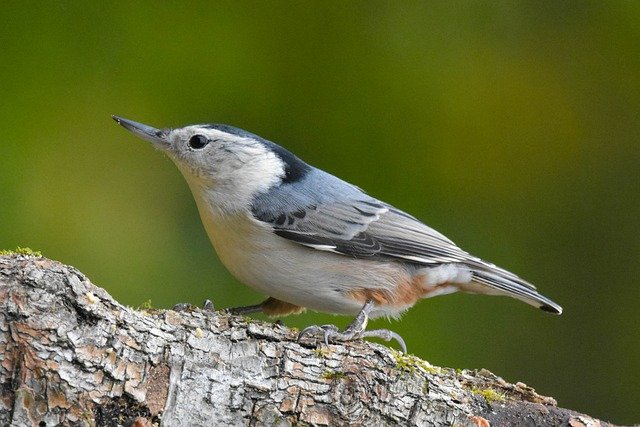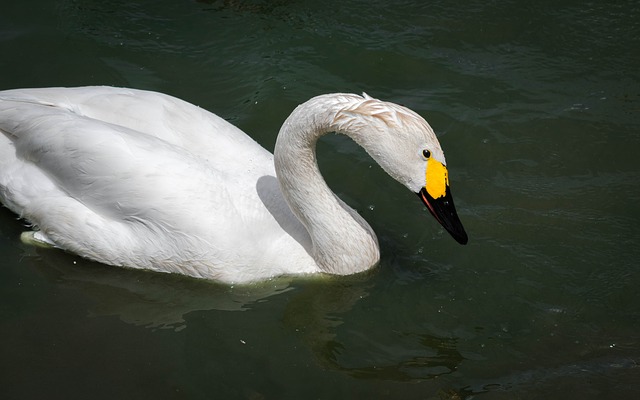This article (as the title suggests) will be covering 5 unique white birds in Ohio, or birds that’s are mostly white, that you can look out for the next time you find yourself in the mood to discover white birds in the wild.
- White Breasted Nuthatch
- Black Capped Chickadee
- Red Bellied Woodpecker
- Tundra Swan
- Great Black Backed Gull
5 White Birds In Ohio
1. White Breasted Nuthatch (Sitta Carolinensis)

- Size: 13 – 14cm
- Weight: 18 – 30 grams
- Wingspan: 20 – 27cm
A white breasted nuthatch can be found in Ohio year round as the state is a permanent residence of theirs.
White breasted nuthatches are recognised by their gray back, wings and the upper head with white breast feathers. Females look the same as the males.
As for where you would find these white breasted nuthatches, it would be around mature woods and woodland edges, where they’re most commonly located by deciduous stands that have maple, hickory, basswood, oak and are even found in some coniferous forests.
They mostly consume nuts, seeds and insects, which can include hazelnuts, sunflower seeds and suet.
As for how long white breasted nuthatches live in the wild, it tends to be around 2 years with the longest lifespan recorded around 12 years.
2. Black Capped Chickadee (Poecile Atricapillus)

- Size: 10 – 15cm
- Weight: 10 – 12 grams
- Wingspan: 15 – 20cm
You can find black capped chickadees in Ohio year round as it is one of their permanent residences in USA.
Black capped chickadees are recognised by their mostly white plumage from breast to tail with gray wings, black throat and upper head. Females look relatively the same.
Your typical chickadee will spend their time within open woods and forest edge, especially where birches or alders grow. They also avoid coniferous forests.
As for what they eat, it mostly consists of insects, fruits, seeds among other berries. The diet does change based on the weather. A large portion of a chickadees diet consists of insects in the summer whilst in winter it tends to be a seed, fruit and vegetable based diet that makes up around 50% of what they eat.
Black capped chickadees are known to live for around 2 – 3 years in the wild although, the longest recorded lifespan is said to be around 11.5 years.
3. Red Bellied Woodpecker (Melanerpes Carolinus)

- Size: 22.8 – 26.7cm
- Weight: 56 – 97 grams
- Wingspan: 38 – 46cm
Red bellied woodpeckers are permanent residents within Ohio so, you’re likely to seem them in the state year round.
Most would recognise a red bellied woodpecker by the helmet like red streak on their head, their white chest feathers and striped zebra like pattern on their back and wings. Being a woodpecker also means their bills are relatively long and pointy. Females are very similar to males besides the lack of a red streak on their head.
Red bellied woodpeckers tend to enjoy consuming suet, especially nut, or fruit blends as well as fruits like oranges, grapes, apples, sunflower seeds and other smaller insects.
As for where they spend the majority of their time, it would be around woodlands and forests, from old oak trees to the lesser aged hardwoods and pines. They can also congregate around feeders.
Red bellied woodpeckers are capable of living for around 12 years in the wild.
4. Tundra Swan (Cygnus Columbianus)

- Size: 120 – 147cm
- Weight: 3.8 – 10.5kg
- Wingspan: 160 – 175cm
Tundra swans tend to migrate through Ohio although the odd few will stay around northeast Ohio when not breeding.
These swans are recognised by their entirely white plumage, with black and yellow beaks. Male and female tundras look the same but, the bills of males will swell up in breeding season unlike the females.
You’ll often find these swans around near the coast. During migration and through the winter, they inhabit shallow lakes, slow-moving rivers, flooded fields, and coastal estuaries.
As tundra swans are herbivores, they will primarily eat roots, stems and leaves of aquatic vegetation, such as mannagrass, pondweeds, and even algae.
The average lifespan for these birds is around 10 years although this lower number is due to the various diseases these swans to suffer from. If a tundra swan is in good health throughout their lives, staying alive for 20 – 24 years isn’t too far off from what’s possible.
5. Great Black Backed Gull (Larus Marinus)

- Size: 64 – 79cm
- Weight: 0.75 – 2.3kg
- Wingspan: 150 – 170cm
These gulls can be found in Ohio but, their numbers are quite scarce there. If you do find them in Ohio, it’ll likely be around the winter period when they aren’t breeding.
Great black backed gulls are recognised by their black and white plumage where their back and wings are almost entirely black, the remainder of their body white in color, with their beak and legs yellow in color. Females have a more patterned black, gray and white back with a black beak and gray legs.
When breeding great black backed gulls spend their time in isolated, predator-free zones like piers or islands that are isolated. Throughout the remainder of the year they will disperse away from the colony to feed at sea, along coasts, and at landfills.
As for what these gulls eat, it includes carrion, fish, mollusks, crustaceans, marine worms, insects, rodents, berries, and the eggs of other birds.
The average lifespan of a great black backed gull is 14 – 15 years whilst on the top end of the age range some live for double that period.
Amhil Khan, a dedicated nature enthusiast and the founder of BirdsOfTheWild.com, is a passionate advocate for the captivating world of avian wonders. With a deep-seated curiosity about the intricate lives of birds, Amhil’s journey began as a fascination and has evolved into a mission to inspire others to appreciate and protect these magnificent creatures.
Amhil’s love for birds led to the creation of Birds of the Wild, a platform where his expertise in ornithology, coupled with his captivating storytelling, provides readers with an immersive and educational experience. Through his lens and words, he captures the essence of birds in their natural habitats, offering a glimpse into their behaviors, migrations, and the ecosystems they inhabit.

